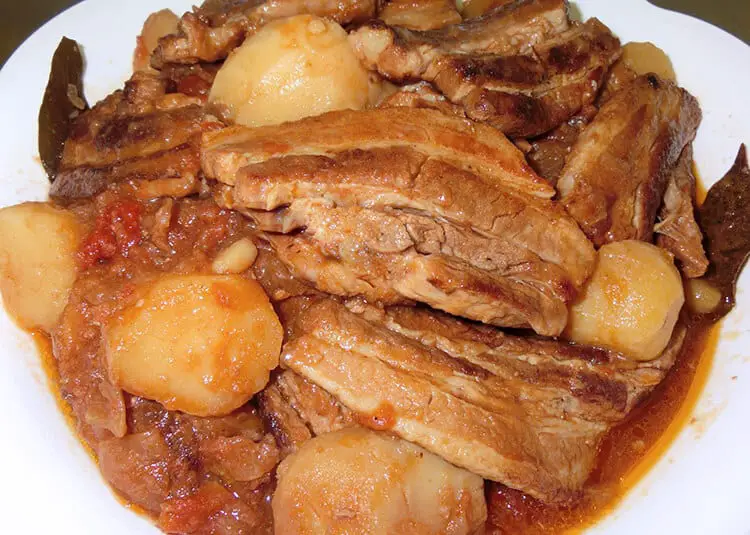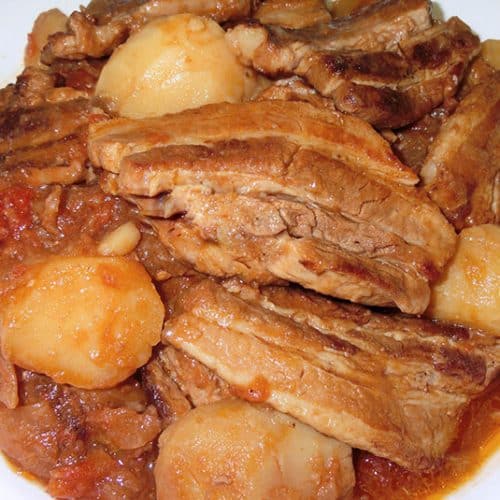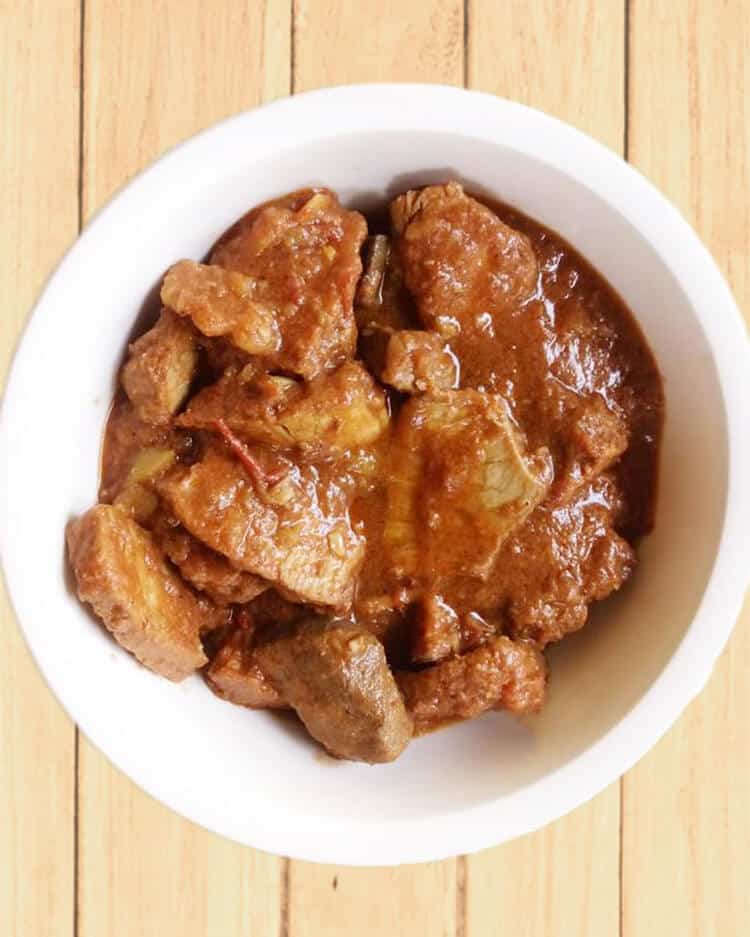Pork asado recipe (Asadong baboy) with star anise & five spice
If you love Filipino cuisine, then you’ll love this dish, which came from our Chinese friends!
This pork asado recipe has a Chinese origin and it combines the tastiness of braised pork with the sweet and spicy seasonings of five spice powder. The end result is a tender and flavourful dish that’s perfect for any occasion!
To date, so many Filipinos love it, and even tourists who visit the country try this one-of-a-kind sweet and salty dish. So why don’t you give it a try yourself?



Check out our new cookbook
Bitemybun's family recipes with complete meal planner and recipe guide.
Try it out for free with Kindle Unlimited:
Read for freeIn this post we'll cover:
Pork asado recipe (Asadong baboy)
Ingredients
- 1 kilo pork belly, shoulder, or loin
- 2 tsp five spice powder
- ½ cup soy sauce
- ⅓ cup brown sugar
- 1 tsp garlic minced
- 1 pc bay leaf
- 1 pc star anise
- ¼ tsp salt
- 2 cups water
- 2 medium-sized potatoes (optional)
Instructions
- Combine the soy sauce, five spice powder, garlic, and salt. Then mix well.
- Marinate the pork in the combined mixture for at least 1 hour.
- Heat a cooking pot, then put in the pork along with the marinade and water. Then let it boil.
- Add bay leaf and star anise.
- Add brown sugar and stir to distribute evenly.
- Simmer for about 40 minutes, flipping the meat after 20 minutes or so to tenderize the other side.
- If the sauce dries and pork isn't done yet, add more water. Boil over low fire until sauce thickens.
- Turn off the heat and remove the meat from the cooking pot.
- Allow the meat to rest for about 10 minutes, then slice.
- Transfer to a serving plate and top with the thick sauce.
- Serve with hot rice.
Video
Nutrition
Check out YouTube user Kuya Fern’s Cooking’s video on making pork asado:
Cooking tips
The key to making this dish is to use good quality pork and authentic Chinese five spice powder.
The acids in the marinade will disintegrate the protein fibers and cause the pork to become mushy if you marinate it for an excessively long time. Anywhere between 30 minutes to 12 hours will suffice.
If you want to make the meat more tender, add a splash of cooking rice wine into the marinade. For a more authentic pork asado flavor, use Chinese rice wine instead of cooking wine.
You can also use pork tenderloin for this recipe, but it’ll cook faster since it’s a leaner cut. Just be careful not to overcook it.
If you use pork shoulder, you can also cook it longer until it’s fork-tender.
If you want a heartier dish, you can add some potatoes towards the end of cooking. Just be sure to simmer until they’re cooked through and adjust the cooking time as needed.
When you need to thicken the sauce to your desired consistency, you can do so by either simmering it longer until it reduces or by adding a cornstarch slurry.
To make a cornstarch slurry, mix 1 tablespoon of cornstarch with 2 tablespoons of water. Stir until there are no lumps, then pour into the sauce. Simmer for a minute or two, until the sauce has thickened.
Substitutions & variations
You can also opt to bake pork asado instead of simmering it. Just preheat your oven to 375 F, then bake for about 45 minutes to an hour, or until the pork is fully cooked.
If you’re short on time, you can also use a pressure cooker for cooking pork asado. Just simmer for about 15 minutes or until the pork is fully cooked. It should be lightly browned.
If you want a crunchy texture, you can fry the pork slices first.
In addition, you can add chopped onions with tomato sauce if you like your asado to be more like a pork stew.
The main condiments for this dish are five spice powder and soy sauce. Five spice powder is made up of seasonings like cinnamon, fennel, cloves, star anise, and Sichuan pepper; this last one adds a spicy kick!
Some people even add guajillo peppers to add even more heat to this dish! But you can also use other spices like dried oregano, garlic powder, and onion powder.
You can also add some green bell peppers, tomato sauce, red chili sauce, or calamansi juice if you want to enrich the flavor of the pork belly or pork loin.
Another option to add more flavor is to add some tinned liver spread. This adds texture and thickens the sauce.
The Chinese name for asado is “char siu”; the Filipino name is “asadong baboy”. The Filipino version of the pork asado recipe isn’t grilled, but instead, braised. So you can make a variation by grilling the meat instead of cooking it in a large skillet.
There are even 2 ways to prepare asado here: one is Asado buns, and the other is this recipe.
The way to cook this is to braise the meat in soy sauce, garlic, bay leaves, onions, brown sugar, and Chinese spices like star anise and five spice.
How to serve and eat
Pork asado is usually served with steamed white rice or pan-fried potatoes and atchara (pickled papaya slices).
Pan-fried or mashed potatoes make for a good side dish because these are hearty sides. You can even add some vegetables like sauteed broccoli or cauliflower.
It can also be served as an appetizer or main dish with other sides like potatoes, plantains, and salad.
When eating pork asado, you can either shred the meat or slice it into thin strips.
Serve hot, and enjoy!

Similar dishes
This pork dish uses a thick slab of meat which is cut after cooking, much like lechon kawali.
But this dish is also similar to humba, hamonado, and pata tim.
Humba is a dish that’s very similar to pork asado. Both are sweet and salty, but humba uses more sugar than asado.
The difference between this dish and humba is the ingredients. In humba, aside from pork, the cook must also use pineapple juice, vinegar, banana blossoms, and whole peppercorns.
On the other hand, pata tim makes use of pork knuckles instead of meat variants of pork. Some cooks also use mushrooms and bok choy for this dish.
Another similar food is pork hamonado. It’s also a sweet and salty dish, but hamonado uses pineapple juice as one of its ingredients.

How to store
Pork asado can be stored in an airtight container and placed in the fridge. It can last up to 3 days in the refrigerator.
If you place it in the freezer, it can last up to 6 months.
When reheating, make sure that the pork asado is cooked through before serving. You can do this by checking the internal temperature of the pork; it should be at 145 F.
You can reheat the asado by microwaving it for 2 to 3 minutes or by simmering it in a pan over low heat.
Do not reheat the asado more than once.
Serve up this Chinese-inspired pork dish
This dish is both satisfying and filling. It’ll have you running for seconds and thirds even! It’s no wonder why it’s one of the most popular recipes for hearty dinner meals.
Don’t be intimidated by asadong baboy. It’s easy, and all you really need to do is marinate the meat and then cook it on medium-high heat.
It’s a must-try dish and a dish that even kids will love because of its sweetness. So don’t forget to include this pork asado recipe on your menu today!
Also check out this Filipino lechon pork belly recipe
If you want to learn more about pork asado, then read this article.
Check out our new cookbook
Bitemybun's family recipes with complete meal planner and recipe guide.
Try it out for free with Kindle Unlimited:
Read for freeJoost Nusselder, the founder of Bite My Bun is a content marketer, dad and loves trying out new food with Japanese food at the heart of his passion, and together with his team he's been creating in-depth blog articles since 2016 to help loyal readers with recipes and cooking tips.
